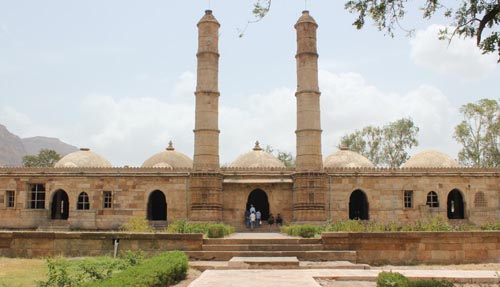Champaner-Pavagadh

Information on Champaner-Pavagadh (Panchmahal, Gujarat) - History & Architecture
The Champaner-Pavagadh is one of the famous archaeological parks that are situated in the Indian state of Gujarat. The park is specifically located in Panchmahal district of Gujarat. The significance of the place can also be comprehended from the fact that it is a UNESCO World Heritage Site. This particular site is positioned in the Champaner city of the state which has a rich historical heritage associated with it.
Champaner-Pavagadh Architecture
Architecturally, the park has the influence of both Hindu and Muslim style and design owing to the aspect that it was being ruled by both Hindu and Muslim rulers during its existence in the history. The architectural beauty of the park was mainly gained in between the period ranging from 15th to 16th century. The park is situated over an area of 1,329 hectares or 3,280 acres. Apart from the park, there is a heritage zone within the park which is situated and established in an area of 2,429.7 acres. Some of the other sites that were present within the park include Hathikhana, Sindh Mata Kabutarkhana, Maqbara near Patidar Village, Sikander Ka Reuza and Maqbara Mandvi among others. There are numerous Royal precincts that are positioned within the fortified walls of the park. The main entrance gate of the park which was also known as the city gate was made quite strong with much height which further prevents trespassing of the enemy. Collectively, the entire area has several key architectural features that depict the diversified mindset regarding designing of the park.
Champaner-Pavagadh Architecture
As per the reports of the archaeological department and the remnants present in the place, it can be ascertained that the park and its surrounding area has more 1700 years of history associated with it. The place has been built and established in the year 400 A. D. It was specifically built during the chalcolithic period. Historical reports also show that the hills that can be found around the park have been derived from the toe Kalika, the Hindu goddess. The name of the park i.e. Champaner has been imitated from Vania or a Kanbi. The entire city of Champaner is believed to be established during the period of Van Raja of Ahilvada in between the period of Van Raja of Ahilvada. During the period of eleventh century, Ram Gaur Tuar ruled the place and continued to do so until the year 1297. However, after his defeat by Alauddin Khilji, the place was extensively ruled by the latter. Chauhan Rajputs also ruled the place for a brief time period. Furthermore, by the year 1484, the Solanki kings and Khichi Chauhans constructed some of the fort that can be found within the park. Hence, it is apparent that the fort has seen the rule of several rulers in its thousand years of historical existence.
Champaner-Pavagadh Tourism Importance
With regard to tourism, the place is one of the most visited places in Gujarat. Apart from the park which is more than 1700 years old, there are numerous monuments, palaces, temples, mosques and royal residences that attract the attention of the visitors to a larger extent. Apart from that the fact that the park is a part of the UNESCO world heritage group also attracts bulk of tourists specially the foreign visitors. Moreover, the fact that one can reach the place quite easily through roadways is also an encouraging factor for the tourists to visit the place at-least once in their lifetime.
- Andaman Nicobar Monuments
- Andhra Pradesh Monuments
- Assam Monuments
- Bihar Monuments
- Chhattisgarh Monuments
- New Delhi Monuments
- Goa Monuments
- Gujarat Monuments
- Haryana Monuments
- Himachal Pradesh Monuments
- Jammu and Kashmir Monuments
- Karnataka Monuments
- Kerala Monuments
- Madhya Pradesh Monuments
- Maharashtra Monuments
- Odisha Monuments
- Punjab Monuments
- Rajasthan Monuments
- Tamil Nadu Monuments
- Telangana Monuments
- Uttar Pradesh Monuments
- West Bengal Monuments